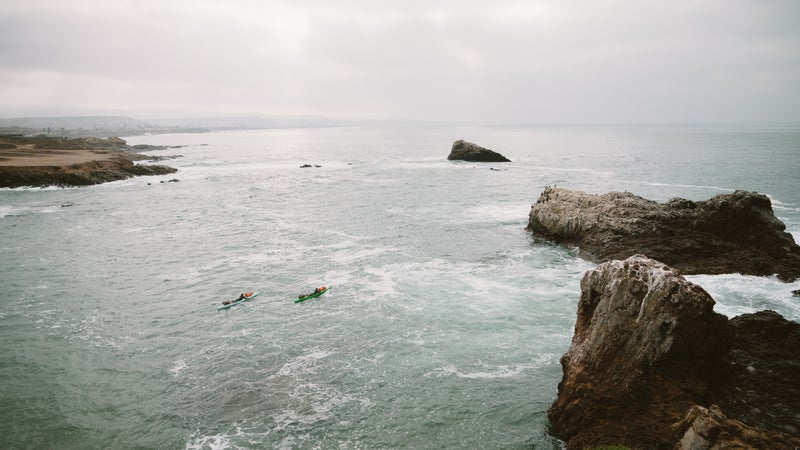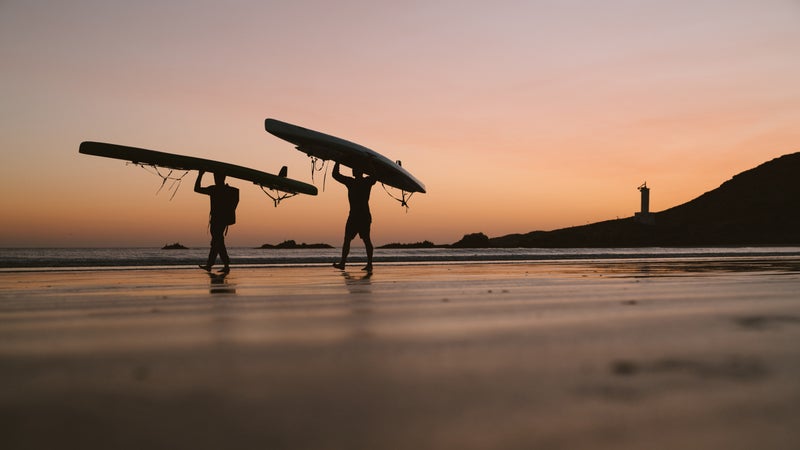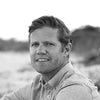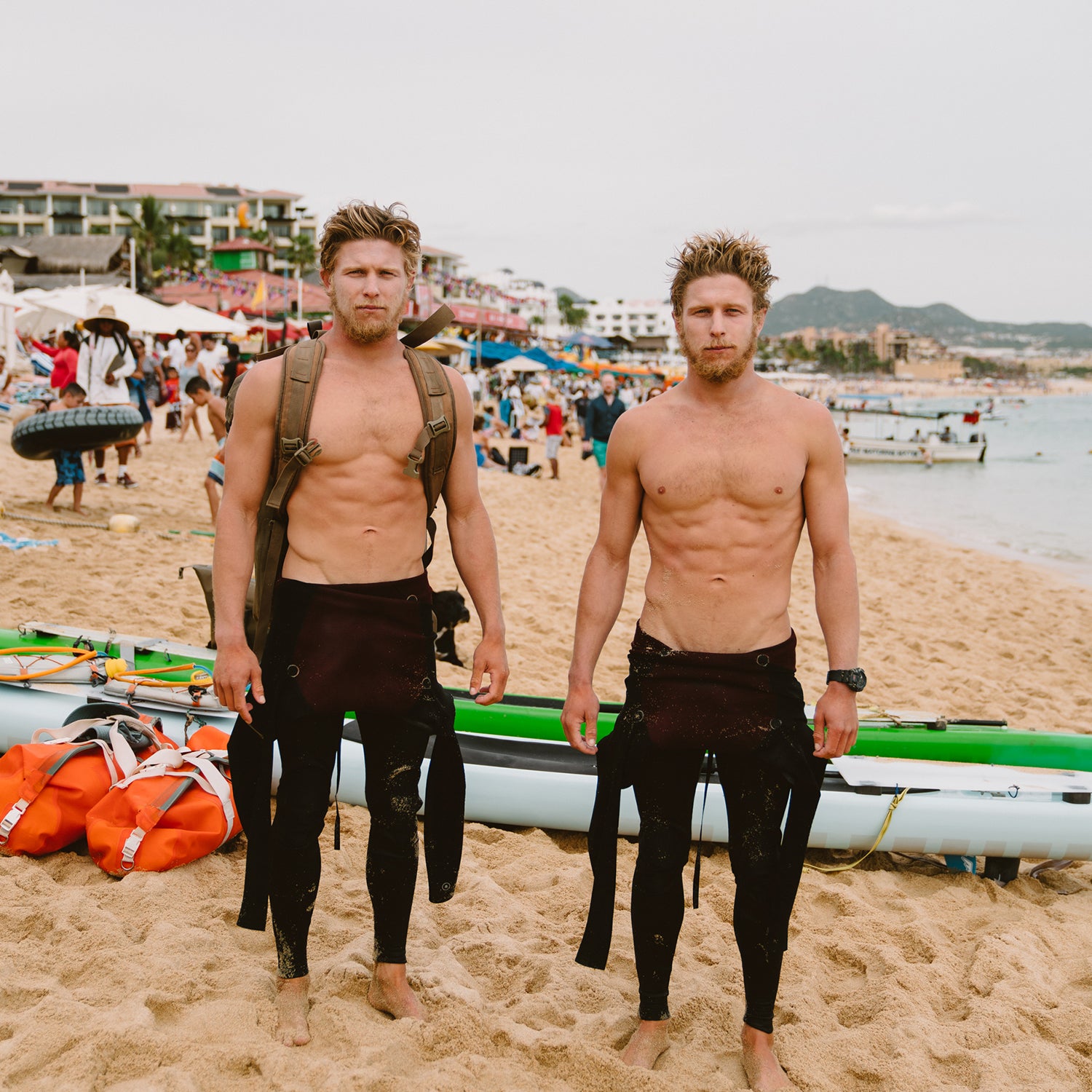“Our tents are breaking down, the plastic racks that we strap the bags onto are damaged from a number of shore-break landings, and the bodies need a few days out of the water to heal up,” Ryan and Casey Higginbotham wrote on New Year’s Eve. “Regardless, it feels damn good to be so close.”
The dispatch came from somewhere along the southwest coast of Baja California Sur, accompanied by an image of Casey leaning against his paddleboard, earbuds in, looking relaxed but spent. And rightfully so—it was nearly the end of a three-month, 1,100-mile prone-paddling��odyssey that began at the U.S.-Mexico border and was set to finish in the shadow of the iconic rock��arch of Cabo San Lucas on New Year’s Day. “We always say, ‘Algún día. Someday,’”��Casey had told me on December 18��from a pay phone in San Juanico, a fishing village just over 300 miles north of Cabo. “You’ll be there someday. Keep going.”
This��he knew from experience.
We have entered the age of corporatized exploration. Every day, it seems, we learn of some grand expedition being undertaken by another brave soul tormented by thoughts of living a pedestrian life. While these people’s desire to break records and push physical and psychological boundaries is real, it is also true that many of them are bankrolled by sponsors. And why not? Exploration is expensive. If slapping a corporate logo on your gear will help get you over the finish line, then by all means start crafting that marketing pitch.
Ryan and Casey Higginbotham’s journey, on the other hand, began unceremoniously and without funds.��And also with a good buzz. Over a few beers in March 2015, the twins, then 22, simply decided it was time, as Ryan put it, to do “something beyond all the bullshit.”��They settled on paddling from��Ketchikan, Alaska, to the U.S.-Mexico border on lifeguard rescue boards, a 2,200-mile feat that had never been done before. When they reached out to companies for support, the response was, “Have you done something like this before?” They had not. “We were starting from scratch,”��Ryan later wrote in an unpublished book about the expedition. They never set up a GoFundMe or Kickstarter page, and no corporate sponsor materialized, though some companies helped out with product—wetsuits, sunscreen, drybags, a mini solar panel. “We started selling things,”��Ryan wrote. “We’d hit the local swap meet every other weekend to sell off clothes and items that were unnecessary.”��They moved in with their parents. And��finally, most painfully, they sold the 1994 Sea Ray speedboat they’d received��from their grandmother.
The Higginbothams grew up in the small, foggy town of Pismo Beach, on California’s central coast. Life there was safe and easy��and revolved around the ocean. In their teens, the��wiry, identical towheaded twins were in the ocean almost every day,��swimming, surfing, rock-jumping, cave-diving. They became swim instructors and then lifeguards, which led to an interest in prone paddleboarding. It wasn’t until the end of college, in 2015, that all of this suddenly seemed like child’s play. They’d grown up hearing their grandfather talk about crash-landing in World War II. Robert, their father, had ridden broncos and fought in Vietnam. To the brothers, these experiences offered the kind of adventure that a million rock jumps or cave dives could never touch. They were young, fit, and good at most anything they tried—what they still needed to test, however, were not so much their physical limits as their psychological ones.
What Ryan and Casey did have plenty of was competitive drive—directed mostly toward each other. “When we were little kids, it was always, Who’s going to jump off the higher cliff?” Ryan told me. “When Casey was 19, he did an Ironman, and I was like, What do I have to do to top that?”��On Christmas Eve 2015, toward��the bottom of a bottle of Jim Beam, the brothers��got into a fistfight—over what, neither can remember—in the kitchen of their parents’ house. Blood��from a well-placed elbow to Casey’s forehead��splattered the floor. In March of 2016, as the boys set off for Alaska, their mother, Shelly, worried not about the brutal elements killing her sons��but about her sons killing each other. “It can suck when your life is a competition,” Ryan said. “But we decided to work together to see what we could achieve.”
To train, Ryan found an old how-to guide for the famously grueling 32-mile Molokai 2Oahu paddle race��and followed it step by step. Still, they never trained with the gear they’d need for the real thing. Perched on their 18-foot Bark paddleboards would be��70 pounds’��worth of essentials—a cookstove, sat phone, extra rudders, medical kit, tent, sleeping bags, an EPIRB (emergency position-indicating radio beacon), flares, and a 12-gauge shotgun��and a box of shells (in case of bears).
Both brothers described the Alaska part of the trip��as a combination of the “highest highs and lowest lows.” On day four, Ryan lost his wetsuit glove while trying to take a photo. He hadn’t packed a second pair. “You sandbagger,” Casey snapped. “You fucked up the whole expedition.” The next day, they were sidelined by heavy wind and rain. Everything settled into a cold dampness. Two months into the journey, as they crawled south along the Washington coast, Casey developed severe muscle pain in his back that no amount of stretching could abate. They tried to stay within a mile of the coast, but during bay crossings, their distance from the shore was greater, and land disappeared behind the fog. “It would come in waves,” Casey wrote��in their book about the 218-day��journey, “blanketing everything in whiteout.”��

When the fog��did clear, the wildness and solitude enveloping them was so immense it felt��medicinal. The agony from the incessant paddling evaporated. Before reaching the United States’ populated West Coast, they often slept on tiny islands dotting the Alaskan and Canadian coasts. They’d wake up to sheet-glass conditions padded by a thin fog bank, and the snow-covered Coast Mountains on the eastern horizon. Perfect strangers could be just as soul-saving. In British Columbia, a woman who was working on her sailboat when the twins paddled up to her dock, soaked and bedraggled, drove them into town to pick up food and supplies.
Seven months after they’d left Ketchikan, their journey ended at the thin, incongruous black fence reaching into the ocean at Border Field State Park, in San Diego. Border Patrol agents shook their hands. Family and friends gave them hugs. But��after it was over, Ryan described that last day as a “melancholic shadow.” “Looking down the coast,” he wrote in the book, “I realized that I will always want to see what lies beyond the next point. The daily struggle is over, the constant need to find solutions to accomplish this goal, and right now all I want is more.”
It didn’t take long for Ryan and Casey to decide they would do another paddle, this time from the border to Cabo San Lucas, 1,100 miles down the Baja��peninsula. For the next two years, they worked odd jobs to save up for the trip. They traveled to a trade show in Munich to talk about the “AK to MX”��paddle.
On October 12, 2018, the twins found themselves once again dragging their paddleboards across the sand at the border—this time, not away from the ocean but toward��it. Again��there was little fanfare, no corporate sponsors, and a measly 5,000 or so Instagram followers. They paddled 14 miles that first day, a solid start. “We made it to Rosarito and it feels good to be back on the water,” they wrote on Instagram. “The body is going to take some time to adjust to this on the daily.”
Compared to the seven months it took to complete the first trip, this journey would be complete in less than half that time. The brothers��had refined their launching technique through rough shore break, which had cost them gear and damaged their boards the first time around. They ditched the heavy boots and Gore-Tex rainsuits for much lighter��warm-weather gear. No shotgun, either. Nevertheless, there was plenty of risk. The majority of Baja’s Pacific coast is desolate, so they’d driven supplies down ahead of time and buried them in the sand, hoping they’d still be there when they returned. The desert winds could be relentless, maddening. Whereas the cold threatened frostbite, the heat threatened dehydration. And there were the sharks and the�������Ի徱�ٴDz�—themselves.
“There’ve been times when we wanted to beat the hell out of each other,” Ryan said from the pay phone on December 18. “But having that goal, and knowing that I’m relying on Casey��and he’s relying on me, supersedes that desire.” Just a couple days before, they’d been sucked into a lagoon south of a windswept headland called Punta Abreojos—“open-eyes point”—and lost an entire day of progress. “When you’re in those moments, you have to let the emotion go,” Ryan went on. “We couldn’t quit on each other.” ��

Between San Juanico and the arch of Cabo San Lucas, the twins had about 330 miles to cover and exactly two weeks to make it in time for New Year’s Day. But��at the last minute, they decided��to arrive in Cabo a day late, in order to accommodate some friends who wanted to be there for the twins’ landing. Both Ryan and Casey already seemed serene about the whole journey, unbothered by the few hundred miles still standing between them and their goal. I wondered if they were pondering future projects. “Casey’s got three pretty terrible ideas written down,” Ryan said. “One of them is going to happen.”
On January 2, the twins passed the arch, several cruise ships, and too many sightseeing boats to count before landing��at a beach crowded with idle tourists baking in the Mexican sun. The brothers��were greasy haired, bearded, and taut with muscle. Some of the tourists looked up from their books or magazines or conversations to stare at the two bedraggled, towheaded��boys who had emerged from the ocean. Others went on without notice. The twins were eager to escape such a “shit show,” as Casey called it.
Later��I asked Ryan if the melancholic shadow had returned. It had. “When you’re out there, you have a lot of time to think, and you build up a narrative of what life will be like when you get back—what you’re going to do, expectations about your personal relationships, how you will feel different on a day-to-day basis,” he told me. “Then once you get back, the narrative is never a reality.” But, he said, the shadow will pass, and the desire to go again will return.


